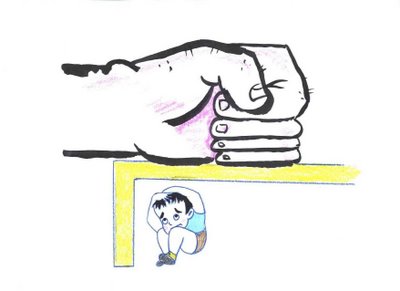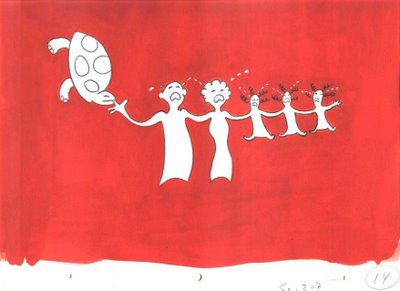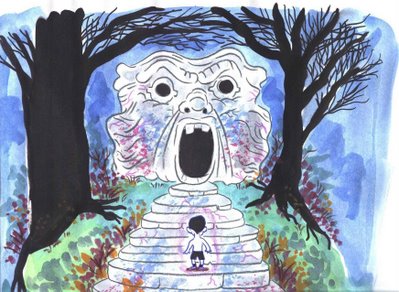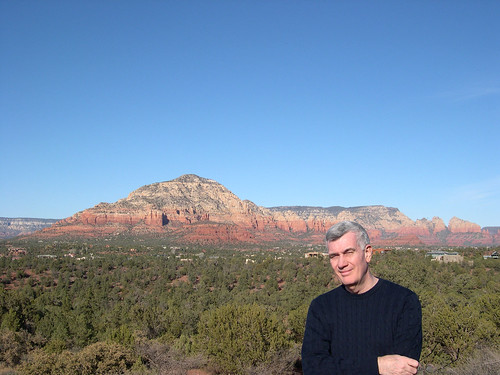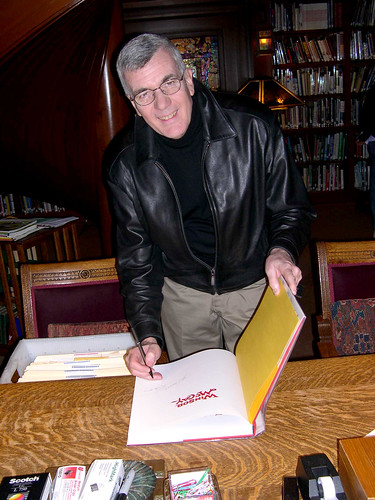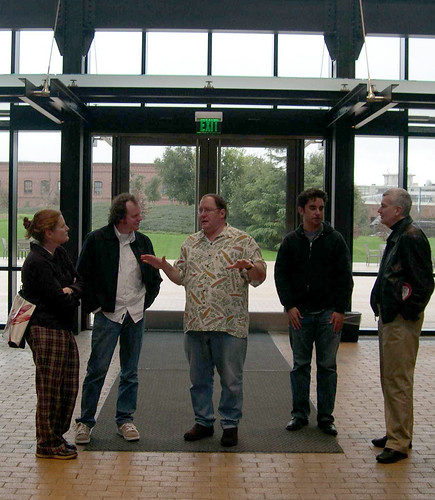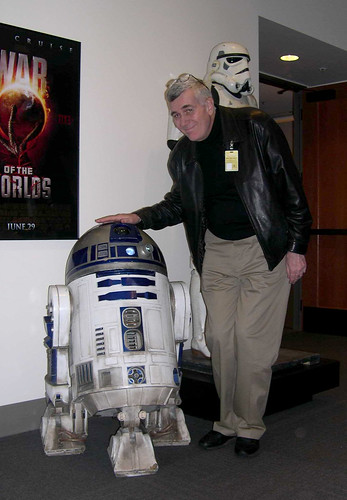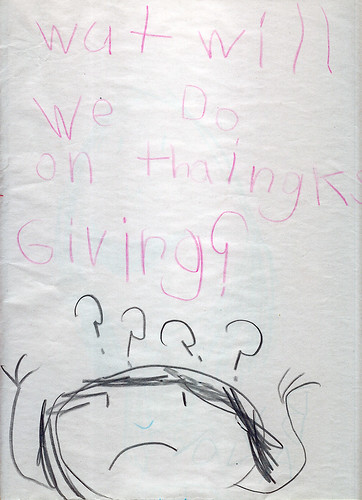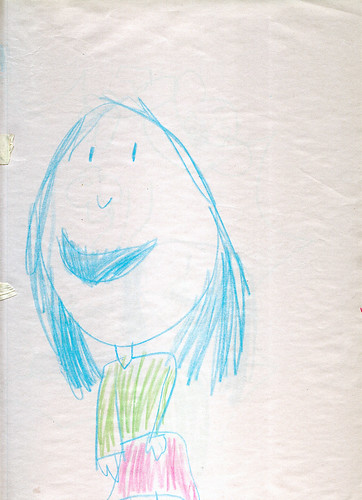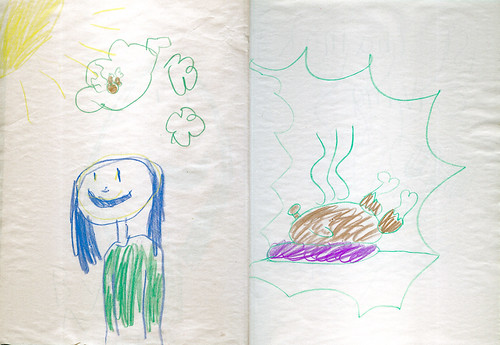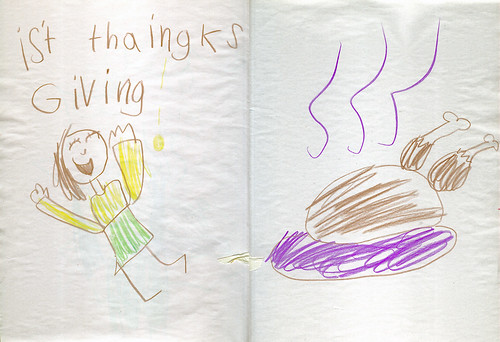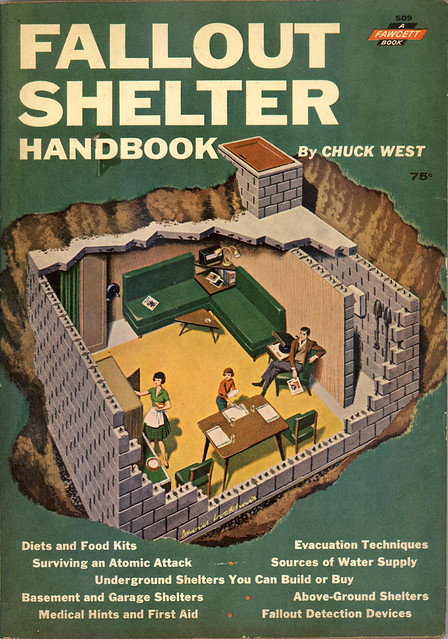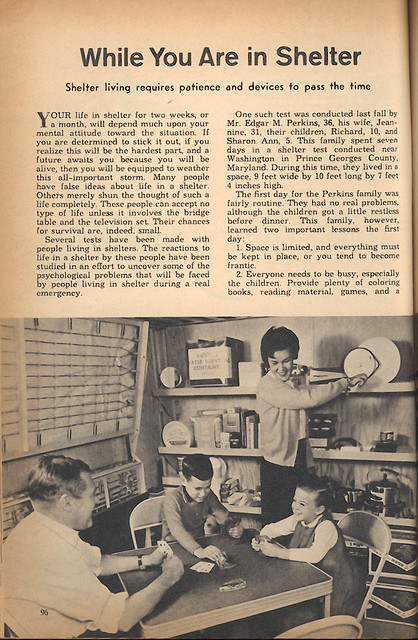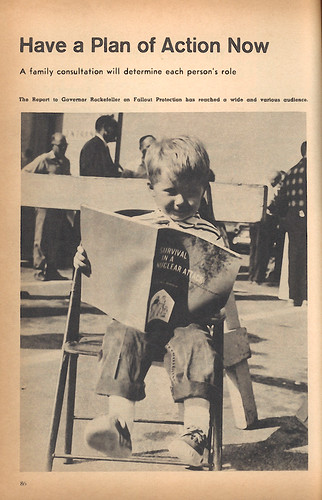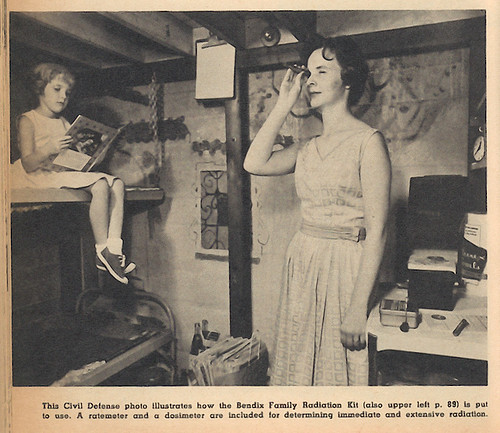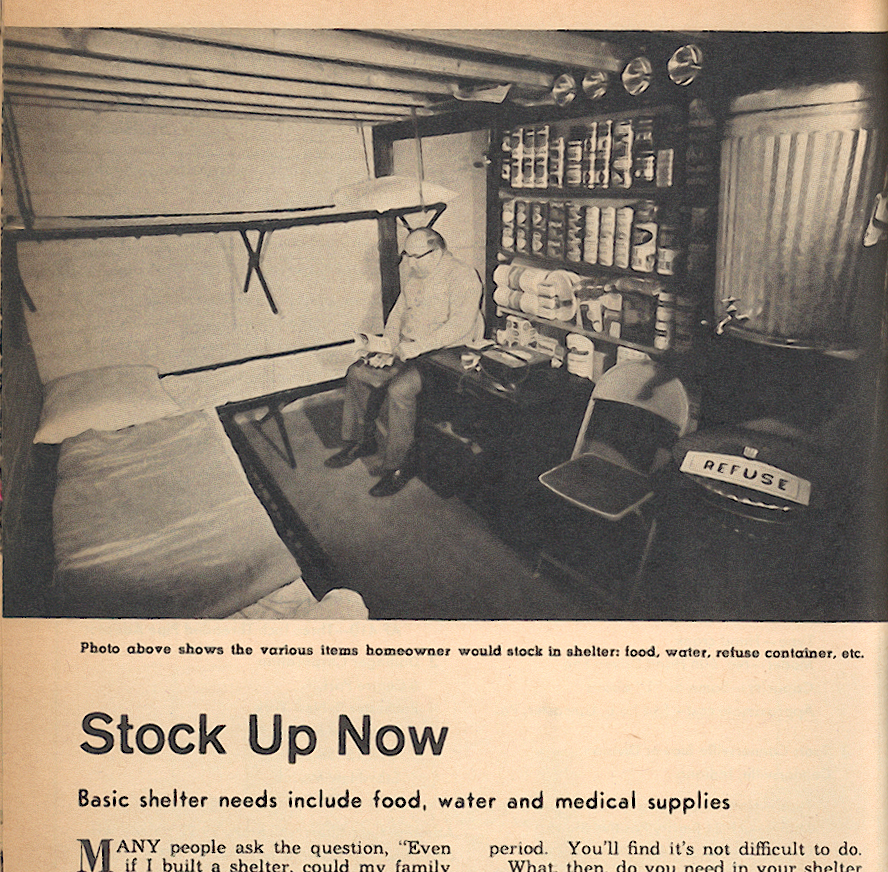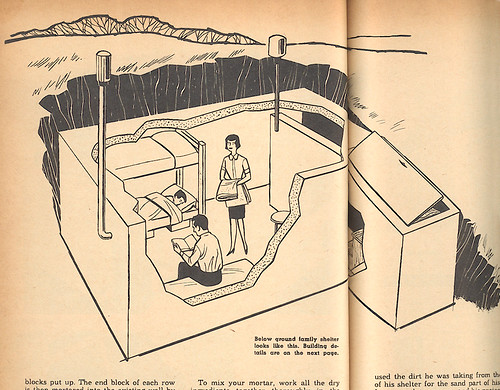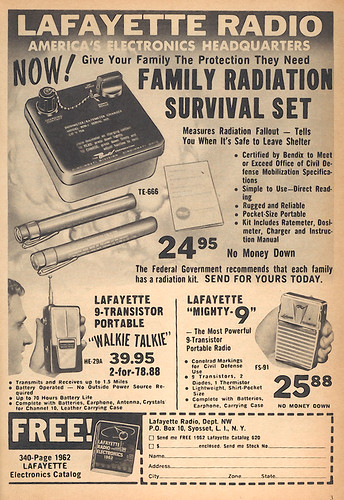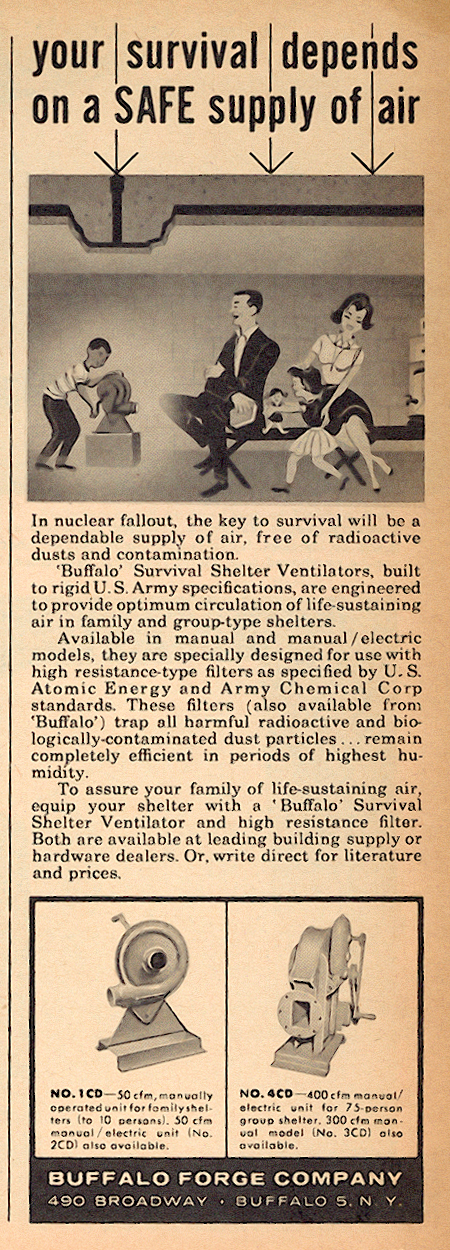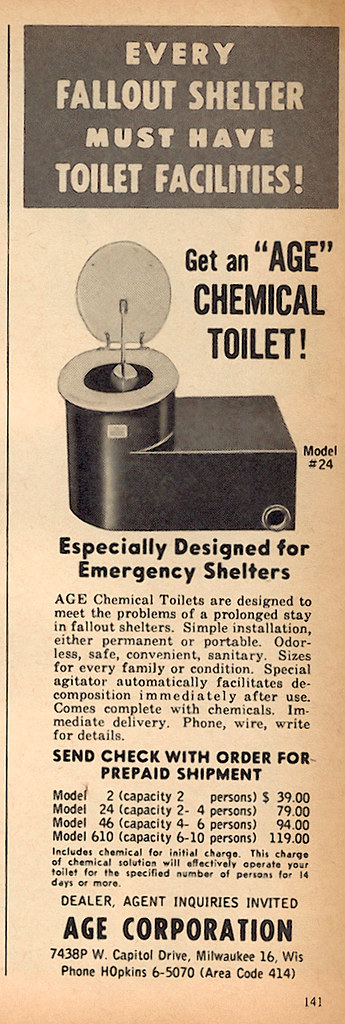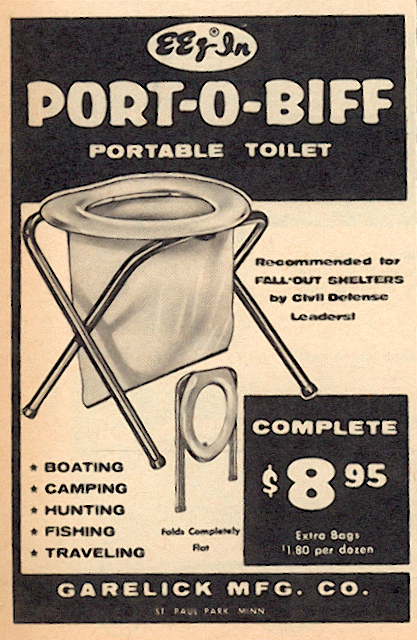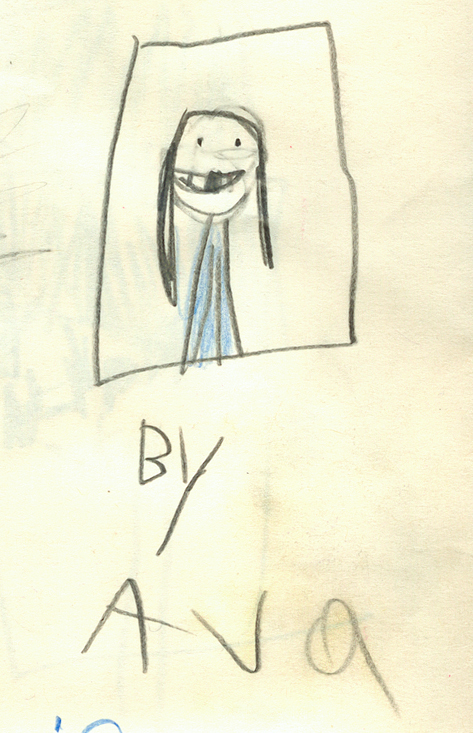LOS ANGELES, AT LAST
John: That evening [Feb 28] we were scheduled to appear at the Academy of Motion Picture Arts and Sciences’ Samuel Goldwyn Theater for a press reception and a screening at 6:30. So when we landed in LA, each of us had about two hours to quickly rent a car, check into our respective hotels, get dressed and head for the Academy headquarters on Wilshire Boulevard.
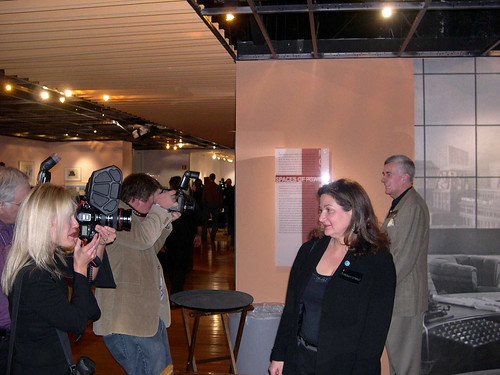
Photographers at the Academy of Motion Picture Arts & Sciences Shorts program showcase on Feb. 28, 2006 shoot THE MOON AND THE SON's producer Peggy Stern and director John Canemaker.
Ward: When you say “each of us” you’re talking about all the nominees? Was all this arranged with all the nominees in mind?
John: Yes. All the short film nominees were involved in the screening, including the live-action group. My producer Peggy Stern flew into LA that morning. She was staying at the Hyatt on Sunset Boulevard where Joe and I were also staying, so we drove to the reception together.
Ward: How was that event?
John: It was great fun—a real Hollywood scene. Lots of photographers and all the nominees—animation as well as live-action —were interviewed by a variety of TV and print reporters. There was finger food, drinks, many air kisses and air hugs. Then we were escorted into the grand Goldwyn Theatre which seats over I,000—and every seat was filled! It was standing room only. We were flabbergasted.
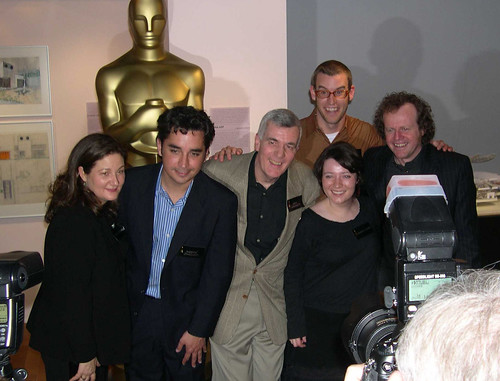
The Animated Short Film nominees at the Academy showcase on Feb. 28,. 2006 pose for photographers: (l. to r.) Peggy Stern, Andrew Jimenez, John Canemaker, Shawn Acker, Sharon Colman, and Anthony Lucas.
Ward: That’s great. You all deserve it.
John: I sat behind John Lasseter and Ed Catmull, who flew down for the screening. The animated films were screened first, after which Chris Wedge, the evening’s host, brought all of us on stage for a single question each. That’s all there was time for.
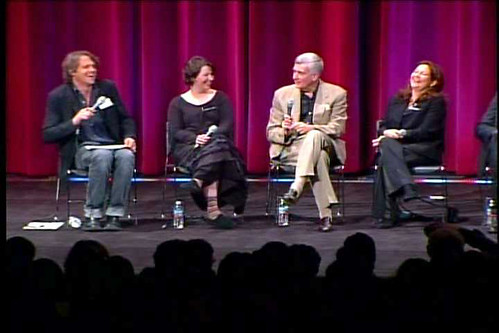
On stage with Chris Wedge as he interviews Sharon Colman, John Canemaker and Peggy Stern at the Academy screening of Animated Short Films (Feb. 28, 2006).
Ward: And what was the one question that you were asked?
John: Something about...was my film based on a real, true story? And I answered “Yes, Oprah!” which got a laugh 'cause Oprah had recently chastised author James Frey on the air for being less than honest in his book, which she heavily promoted on her show.
Afterwards, Peg, Joe and I went to a supermarket. We were starving and bought salads and beer, which we ate in my hotel suite. Peg’s son was ill in New York, so she spent a considerable amount of time in LA on her cell phone dealing with doctors, and so forth. He’s fine now, but at the time she was under a great deal of stress, beside the Oscar-thing.
Ward: I can only imagine. Kind of hard to be 100% “on” for everyone with a bunch of drama going on back at home. So, at this point, you had four days ‘til the Oscars.
John: Yeah. The week was filled with a blur of parties and receptions. Thanks to Ron [Diamond], all of us animation Oscar nominees showed our films and were feted by DreamWorks (lunch with Jeffrey Katzenberg), Disney (lunch with Don Hahn, Howard Green, Andreas Deja) and Sony studios (lunch with Yair Landeau, Penny Finkleman Cox and Sandra Rabin).
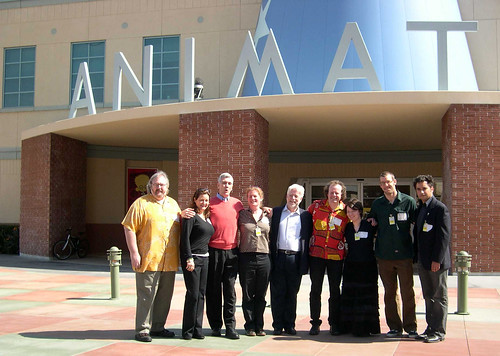
March 2, 2006: the Oscar nominees visit the Disney Studio with friends: (l. to r.) Don Sarto (editor, Animation World Network), Peggy Stern, John Canemaker, Julia Lucas, Ron Diamond (publisher, AWN), Anthony Lucas, Sharon Colman, Shawn Acker and Anthony Jimenez.
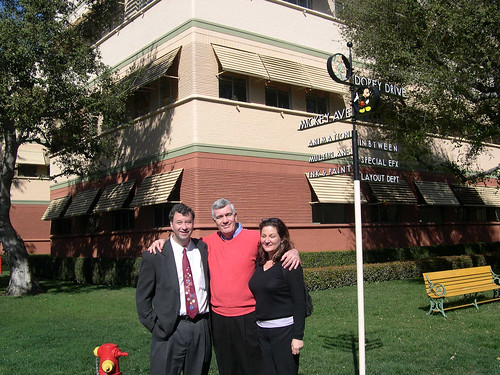
On the Disney Studio lot with Howard E. Green, v.p. Studio Communications and "patron saint of animation historians," with John Canemaker and Peggy Stern on March 2, 2006.
Ward: Wow. Some pretty big names there. Were you given tours of each of the studios? Care to elaborate?
John: Each studio visit included a tour, and we saw storyboards and concept art for features planned for years in the future. And there were many parties. A fun one was thrown by DreamWorks, their annual Animation and Visual Effects pre-Oscar party at Eat On Sunset restaurant. There I met Peter Sallis, the voice of Wallace in the Wallace and Gromit movies. Another party was HBO’s at the Peninsula Hotel; another by Ron Diamond’s company Acme Filmworks at Joseph’s Café on Ivar Street; and a private party by friends of mine who live in Gary Cooper’s former home in Beverly Hills. I also attended an NYU fundraiser party at producer/director Brett Ratner’s home in Benedict Canyon.
Inbetween all that, I did an on-camera interview for a documentary on Tyrus Wong, and had dinner with old friends—Charles Solomon and Scott Johnston at Chameau, a terrific Moroccan restaurant—and former NYU students, Eugene Salandra, now in story at Disney Television and Sue Perrotto, who is directing at Cartoon Network. We ate at El Cholo, the best margaritas and Mexican food in LA! Sue is a bird fancier and she gave me a “magic feather” to help me “fly” on Oscar night like Dumbo. And Dumbo-like, I promptly lost the feather.
Ward: I bet some Oscar-goer was wondering why a feather was stuck to the bottom of their shoe that night.
HBO KICKS IN
John: Saturday, the day before the Oscar show, HBO—which paid for most of my film’s budget—took over. They organized everything: from ordering a stretch limo to assigning two publicists who would accompany Peg and me on the red carpet; arranging our attendance at after-show parties (including the Vanity Fair party). And they also moved Peggy, her husband Alan, me and Joe to the Beverly Wilshire, one of the most posh and well-run hotels I’ve ever had the pleasure to be in. We were staying at the Sunset Hyatt, also known as the Sunset Riot because of the noisy parties that go on there constantly. The Beverly Wilshire is pure deluxe. HBO also gave us each a food per diem and business class seats on our return flight to New York.
Meanwhile, Peg and I kept practicing our speech, just in case we won. The Academy sends you the most nerve-wracking DVD starring Tom Hanks, who tells the nominees what they can and cannot do on stage if they win. Can’t read from notes, must look into the camera, must say something memorable, and so on. Jeez! The most frightening information on the DVD was Hanks saying we have exactly one minute [!] from the time our names were announced to get up on the stage, make our speech and get off!
Ward: That’s nuts! How do they expect anyone to not be nervous after viewing that DVD? Were you scared after that?
John: Petrified. So Peg and I each wrote out what we wanted to say. In our hotel rooms at unexpected times, Joe would yell: “Go!” and then time us as we ran across the room, picked up an ashtray or Coke can, held it and went into our speeches. And we screwed it up each time! But since we were convinced we would never win, we weren’t terribly worried.
DAY OF THE OSCAR
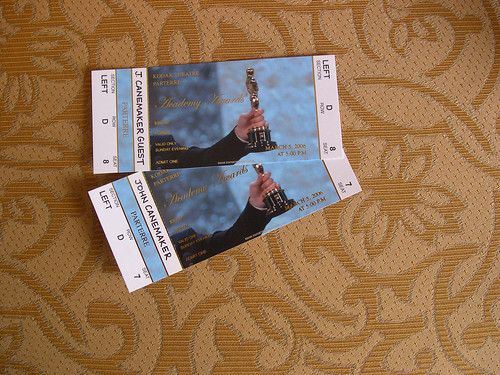
John Canemaker's tickets to the Academy Awards ceremony.
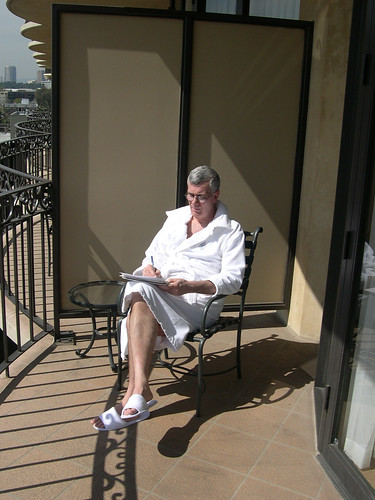
John Canemaker at 1 p.m. relaxes at the Beverly Wilshire Hotel, an hour before leaving for the Oscar ceremony on Sunday, March 5, 2006.
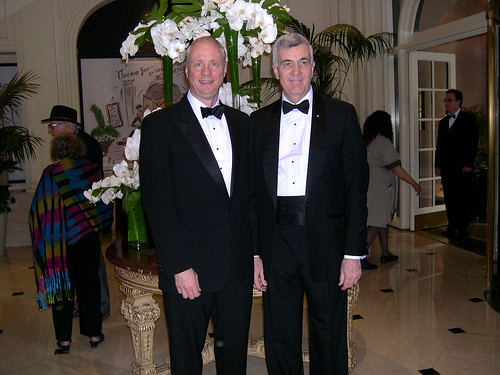
All dressed up and somewhere to go: Joseph Kennedy and John Canemaker waiting in the lobby of the Beverly Wilshire Hotel for the limo that will take them to the Oscar show.
Ward: Talk about the day of the Oscar show.
John: Well, the limo picked us up at two in the afternoon. It was a beautiful LA day—bright sunshine. There we all were in our tuxes and formals, like we were going to the ultimate prom: Joe, Alan, me, Peg, Peg’s brother Tom Stern, Dave Mehlman, the film’s editor/sound designer who flew out just to be part of the whole shebang, and Lana and Jessica, the two HBO publicists—all eight of us rode in the limousine. Darby Scott, a friend of Peg’s who makes expensive handbags for the stars, designed her dress. And she loaned Peg a gold weave purse with diamond inlays. It was worth about $120,000, which we joked was more than the budget for our film!
Ward: Unbelievable! Your entire film budget right there in Peg’s hands....What was the limo ride like?
John: The limo drive took about 30 minutes to get to the red carpet site at Hollywood Boulevard. There was a lot of traffic and crowds along the way—including some crazies holding signs saying we were going to burn in hell—but what a way to go, right?
Ward: Absolutely.
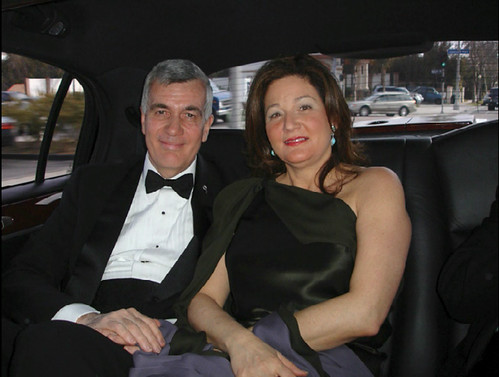
John Canemaker and Peggy Stern in the limo on the way to the Oscar ceremony.
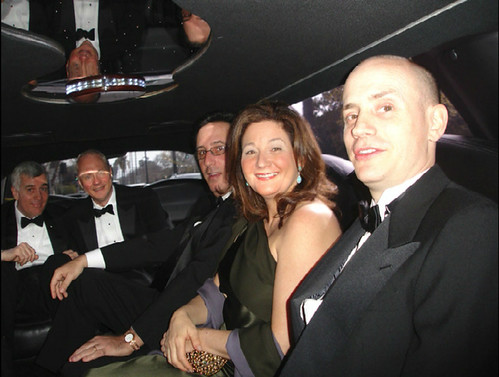
On the way to the Oscars: (l.tor.) John Canemaker, Joseph Kennedy (one of the film's writers), Tom Stern (radio personality and Peggy's brother), Peggy Stern, and David Mehlman (the film's editor and sound designer).
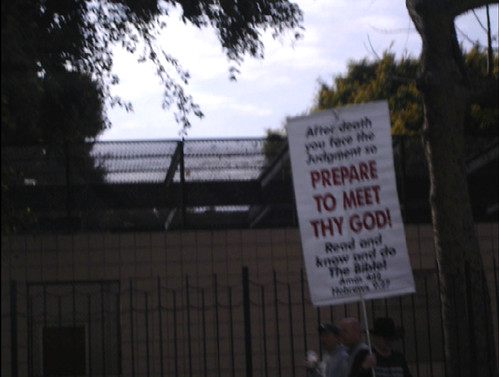
A quick snapshot of one of the signs from some Oscar-haters, en route to the ceremony.
John: The whole Oscar ritual is so well-organized that it was like being part of a smooth-running, super-greased machine. At Hollywood Boulevard, there were large crowds behind barricades across the street who were yelling and cheering every arriving limo. Security was incredibly tight. Each car was inspected underneath with mirrors when we got near the entrance to the red carpet, and we entered a tent where everyone’s photo ID was checked, and we were each “wanded” by guards like at the airport, and all cameras were confiscated until after the show.
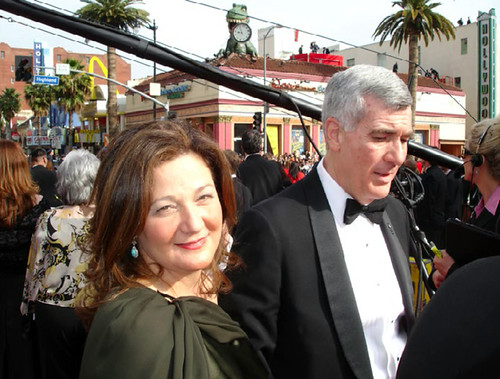
Peg and John arrive at the Kodak Theater and step out onto the Red Carpet.
Finally, we exited the tent and walked onto the red carpet—which was lined with banks of reporters and cameras. Behind us were huge statues of Oscar (like statues out of a de Mille epic), and sets of bleachers filled with thoroughly-inspected, cheering movie fans.
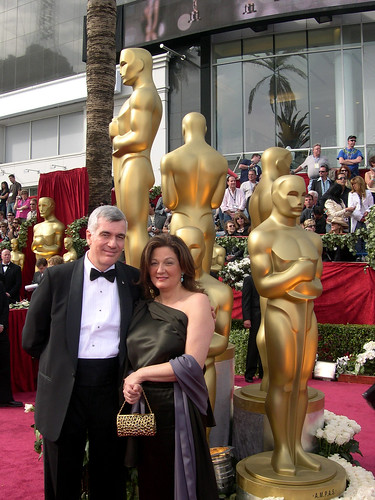
John Canemaker and Peggy Stern (and her expensive pocketbook) on the Red Carpet at the Academy Awards.
Our publicists proceeded us and handed out information about our film and us. They waited until a celebrity was far enough away so we could attract the attention of the press. I mean, who the hell were we—a couple of animation short producers—compared to George Clooney or Jennifer Aniston? Some reporters from overseas spoke with us but the “interviews” were brief and banal. “How does it feel?” was the most asked question. Mostly we were feeling like a couple of pieces of sushi.
So we walked the walk and said hello to Robert Osborn from Turner Classic Movies, and my old friend Leonard Maltin gave us a good luck hug. The publicists thought Joan Rivers would love to gab about Peg’s expensive bag, but she was getting her lips glossed and passed on it and us.
Ward: It’s probably a good thing you weren’t accosted by Joan. You never know with her.
John: We finally went inside the Kodak Theatre, up the grand staircase into the lobby where food and drink were served. I was too nervous for any of that. My friends Charles Solomon, Scott Johnston and Andreas Deja were there and wished me and Peggy luck. We all decided to enter the theatre early and watch the stars arrive, which most of them did right at the last moment before broadcast. Must have been busy on the red carpet.
Ward: What stars were you able to spot?
John: George Clooney, Dolly Parton, Matt Dillon, Reese Witherspoon. And, of course, Nick Park and Steve Box and their big bowties.
Ward: What was the theatre like? I know it’s fairly new.
John: It was a big television studio set. When I walked in and saw the cameras and the crew going about their pre-show activities, I felt strangely comfortable. I guess because I’ve done so many TV shows and been on so many sets. The theatre seats 3,400, but the Academy Award set on stage had an intimate feel, seemed smaller than it appears on TV. It was very glitzy and white. Which meant it would look really bright and sparkling on camera.

Shot of the animation nominees at the Academy Awards. (©2006 The Academy of Motion Picture Arts and Sciences & ABC, Inc. All Rights Reserved.)
All the animation nominees were seated together near the back. A crew member with an earphone named “Heath” came by and told us that during the second commercial break, he would move us to seats right in front of the stage. And “extras”—beautifully dressed unknown actors and actresses—would fill in our seats, so the theatre would always look full on camera.
Ward: An episode of Seinfeld comes to mind. Were you nervous?
John: I was enjoying just being there, spotting celebs. I was excited but not nervous. I knew we weren’t going to win, so I was just enjoying the experience. When Heath did escort us to the front before our category was announced, I again felt this is what one does before performing—getting into position. I was sure that Pixar was going to take the award, so I wasn’t even worried about my speech, cause I knew I’d never have the chance to recite it.
 Ward: And then a CGI Chicken Little looked in his underwear and announced your film and you and Peg...
Ward: And then a CGI Chicken Little looked in his underwear and announced your film and you and Peg...John: Yes! Very classy intro, eh? Of course, there was nothing, no chicken on stage, but on the monitors we saw what the TV audience saw. Peg and I were both shocked for a moment. Then we quickly got up and made our way up the stairs to the stage. The cameras didn’t catch me making a “who knew?” gesture to my fellow nominees.

Peggy and John take the stage. (©2006 The Academy of Motion Picture Arts and Sciences & ABC, Inc. All Rights Reserved.)

John giving his acceptance speech with producer Peggy by his side. (©2006 The Academy of Motion Picture Arts and Sciences & ABC, Inc. All Rights Reserved.)
Ward: And you somehow remembered your speech.
John: Yes, by some miracle, it all kicked in. First time we did it correctly. And my line—thanking the Academy for their belief “that hand-drawn animation can still pack an emotional wallop”—got a nice ripple of applause from the balcony. From several animators, no doubt.
Ward: Believe me, I was cheering for you at home and even more so when you said that! On behalf of all hand-drawn animators, we thank you.
John: I’m biased, of course, toward drawing, but it does seem to me the more layers of “reality” you strip away in animation, the more soul is revealed. It’s a paradox. When ultra-real CGI goes in for extreme close-ups of fuzzy animals, I start to count the hairs on their fur. And that distracts me from the narrative. Story is the most important element of the process, not the tools used to tell it, and...well, now I‘m getting away from the story I was telling you.
Ward: That's quite alright. You were giving your speech...
John: Anyway, the Oscar statues are surprisingly heavy—8 and a half pounds. And by the way, there is dead silence on stage during the speech, I assume so the winners will not be distracted in any way. That light music playing underneath is only heard on the public’s television sets and is pre-recorded. At the end of the speech, the live orchestra comes in with the winner’s exit music.
Ward: What was it like backstage?
John: That was one of the most amazing things about the whole experience. Immediately, the moment you get off-stage, the one-word whispering begins: “Congratulations!” As we were ushered through the dark labyrinth, down corridors, into an elevator and up to the press rooms, everyone we came in contact with or passed by—grips, gofers, techies, guards, executives, p.r. people, extras, stars—all whispered “Congratulations!”
Our arms bearing the two statues were like torches that turned people on as we swept through the backstage area. It reminded me of the living, torch-bearing arms in Cocteau’s BEAUTY AND THE BEAST. Here the arms were mobile—Peg and me—walking fast through corridors alive with whispering, smiling faces.
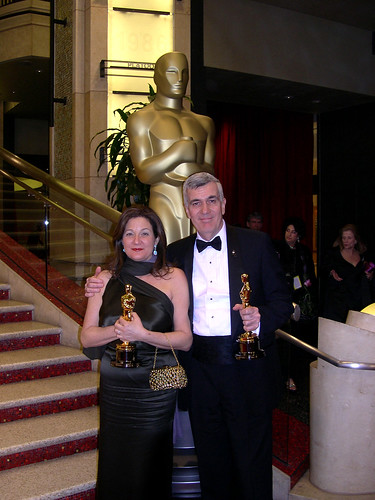
Peggy Stern and John Canemaker leaving the ceremony, Oscars in hand, March 5, 2006.
We were first taken to a room that looked like lightning was flashing behind it’s closed door. It was a room full of photographers and after we were announced, we were told to stand in three spots while the camera men and women yelled at us “Look here, John! Over here, Peg! Here, look here. Good, good. Now step to the middle of the stage.” Then they shot a whole bunch more photos and yelled at us to look various places. By the time we left the room, we were blind!
Then we were escorted to a large silent room, where many reporters were seated at computers. We were asked two questions. And then we were returned to the theatre lobby and immediately surrounded by more congratulations from friends and strangers alike. I stayed in the lobby and missed most of the show. I phoned my brother in Seneca Lake, N.Y. and an old friend in northern California. Course they were surprised to hear from me since they had just seen me on TV. I stepped outside for some air and chatted with Tim Burton and Helena Bonham Carter. I met Tim twenty years ago in Pasadena where I was hosting a Disney Channel TV show. Tim knew the director and dropped by. Back then, he was having a hard time selling a children’s book idea about Christmas and Halloween. Back then he gave me a sketchbook of his marvelous drawings, which I still have.
Ward: Of course we all know what became of that children’s book idea: THE NIGHTMARE BEFORE CHRISTMAS. What did you talk about with Tim? Or was it just small talk?
John: Just small talk. He and Helena congratulated me on the gold guy I was carrying. After the Oscar show, Peg, her husband Allen Ruskin, Joe and I attended the Governors’ Ball upstairs. There was a big band playing, a formal banquet and lots of champagne. I dined at Academy governor Carl Bell’s table and Peg was at John Lasseter’s.
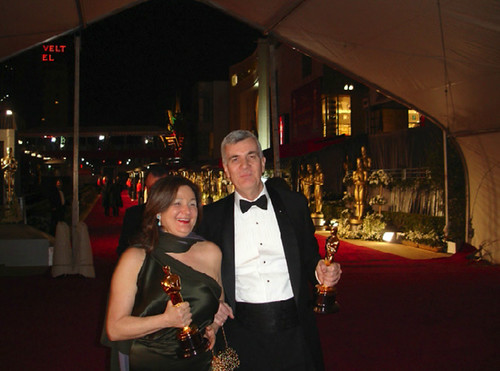
Peggy and John beaming with joy after their win. March 5th, 2006.
Outside, as Peg and I waited for our limousine to take us to the Vanity Fair party, crowds behind the barricades on the opposite side of Highland Avenue and Hollywood Boulevard spontaneously began to cheer when they saw us holding two Oscars. Even though they had no idea who we were. So we hoisted the statuettes in the air in response to their cheers. Which made them cheer even louder. Then I waved mine to those on the other side of the barricades, and they responded the same way. That gave me the idea to play one group against the other—a giddy Sorcerer’s Apprentice moment—“conducting,” with Oscar in hand, the crowd’s cheers—that mercifully ended when I was tucked into the limo.
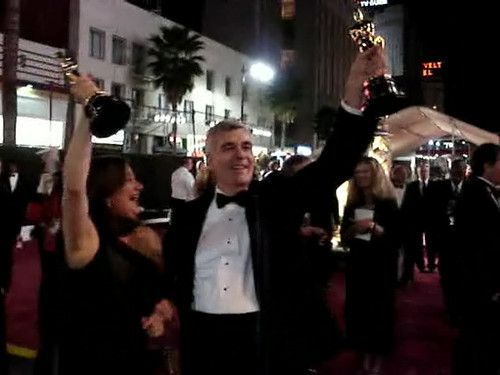
Click on the image above to watch a short video (8 MB) of John Canemaker and Peggy Stern in the limo before the Oscar ceremony, right after their win, and of John doing his best Mickey Mouse as the Sorcerer's Apprentice conducting the crowds outside the Kodak Theatre. At the end of the clip there's a bit of confusion, but what you hear is all the commotion on the plane as John and Peggy's Oscars are being passed around among the flight attendants during their flight back to NYC. (Video courtesy of Allen Ruskin.)
As our limousine pulled up the entrance to the Vanity Fair party, a young guy poked his head inside the window and asked what we had won for. I said, “Best Animated Short.” So he hands me an autograph book and as I am about to sign, he said “You’re Nick Park, right?” When I said no, he took his book back. [laughs]
Ward: [laughing] Oh no! That's terrible!
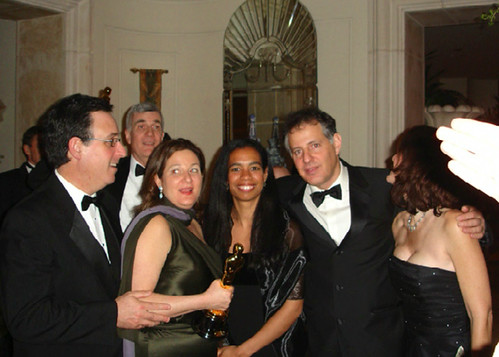
At the HBO party after the Oscars: (l. to r.) Tom Stern, John Canemaker, Peggy Stern, Jackie Glover (one of the film's two HBO Executive Producers), Allan Ruskin (Peggy Stern's husband), and Lisa Stern.
John: Anyhoo, with our Oscars in tow Peg and I brought the dozen or so people who rode with us in the limo into the restaurant. We did another press gauntlet thing on Vanity’s red carpet with the two publicists. Finally we were inside, where there was lots of food, drinks, and people. I had brief conversations with Jon Stewart, Lauren Bacall and Tony Kushner, among others. I thanked Graydon Carter, editor of Vanity Fair, for his party—polite small town boy that I am.
We finally got back to the Beverly Wilshire around 2 a.m. and I started to answer each of the 300-plus emails that had come in. Polite boy that I am.
Ward: I’m sure I was one of them!
John: Yes. I recall you wrote something about my burning in hell. [laughs] In any case, we had to pack and be up early to catch a plane to New York, and there were more fun adventures with Oscar along the way from LA to New York. There was the private airport club we crashed, Oscars in hand. The man in charge said not only would he allow us in, but that he “would be fired if he didn’t.” Then there were the airport check-in guards who made Peg and me take off our shoes and empty our pockets, and they wanded us, too, all the while posing for snapshots with our two Oscars. As did the airline stewards and stewardesses on our flight. They disappeared with them for about a half hour. Everybody seems to go kind of nuts when they see the statuette.
Ward: I can only imagine.
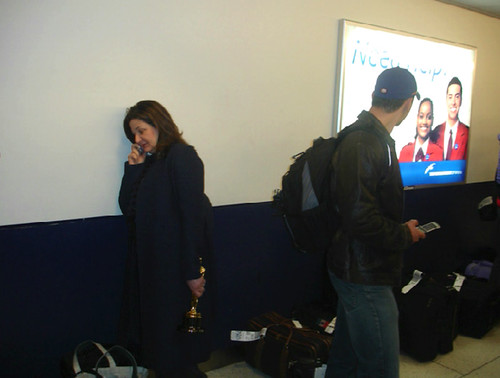
Peggy Stern on the phone at the airport with Oscar in hand.
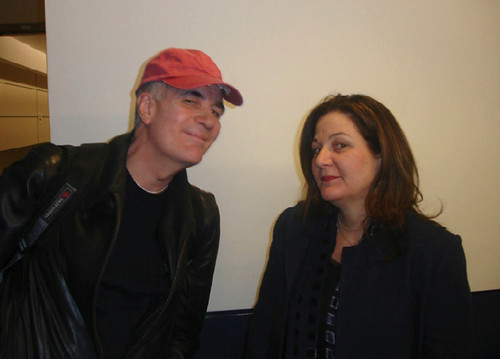
One last shot before we go: John and Peggy at the airport.
John: And then in New York there was a wonderful morning reception from my students and faculty colleagues at NYU with champagne and a cake shaped like an Oscar. It was magic all the way. However, two days after arriving back home in New York, I served on jury duty. Talk about being brought down to earth! THUD! [laughs] Oh well. Keeps ya humble.
Ward: Absolutely. So where do you keep your Oscar, if you don't mind me asking?
John: I keep the Oscar next to my computer, where it sometimes wears my Golden Ear-ed Mickey Mouse hat.
Ward: Now that all the Oscar dust has settled, what's next? Do you have any book or film projects that you're currently working on that you can share?
John: I am guest-director of an episode of the kid's TV series WONDER PETS for Little Airplane Productions. It's called "Save the Pangaroo" and I designed the main character, a little combo-creature that gets lost. A former student of mine, Jennifer Oxley, is the Creative Director of the series. So I'm having a lot of fun. There is another personal short I want to do based on a short story, but I need the time to concentrate on it. Peggy is preparing a documentary on dyslexia and there will be animation in it. Recently, I did on-camera commentaries for a Droopy DVD collection, a Ray Harryhausen DVD collection, and Ted Thomas' [directed FRANK AND OLLIE, son of Frank Thomas] new doc, a work-in-progress on the 1941 Disney artists' trip to South America.
On December 7, I will appear at the Egyptian Theatre in Hollywood to host the DVD launch of the Disney True-Life Adventures, and I'll emcee a panel that includes Roy E. Disney. The first half of my article on Disney story artist and children's book illustrator J.P. MIller will be in the next CARTOONS magazine (published by ASIFA). I have some book ideas; but again, I need time to get my thoughts together. I have a year-long sabbatical from NYU coming in the Fall of 2007 and I hope to use my time wisely then to do some of these dream projects.
Ward: Wow, lots to look forward to. Well, John, this has been an incredible journey for me. I am deeply honored to be able to talk with you personally about your trip to the Oscars. Thank you for your time; I know that you have lots of stuff going on and how precious your time is these days. It's been a great pleasure and I wish you the best of luck in everything that you do.
John: Thank you, Ward.
THANKS AND LINKS:
Big big thanks to John Canemaker, of course, for his generosity for allowing a lowly animator to take a peak into his life during the two weeks of late February and early March, 2006. Big thanks go to Joe Kennedy and Allen Ruskin for the use of their photos and video for this interview. And more thanks goes to John Martz for hosting the video via Drawn! I really appreciate it, guys.
All the photos featured in this interview (and more) can be viewed together in a Flickr photoset: John Canemaker's Oscar Experience.
To read more about John Canemaker through articles and interviews check out the following links:
John Canemaker's Official Website
THE MOON AND THE SON's official page on HBO (with a preview, storyboard slide show and interview)
Full Media Coverage on THE MOON AND THE SON
John and Peggy's Acceptance Speeches
Oscar Press Room Interview (Must have Flash Realplayer to view.)
Buy John's DVD: Marching to a Different Toon
John Canemaker on IMDB
Other John Canemaker interviews you might find interesting:
Animation World Magazine: Part 1, Part 2, and Part 3
The Evening Class (August 2006)
HBO Documentaries (with Peggy Stern)
Animation Blast (2002)
The Laughing Place (May 2002)


